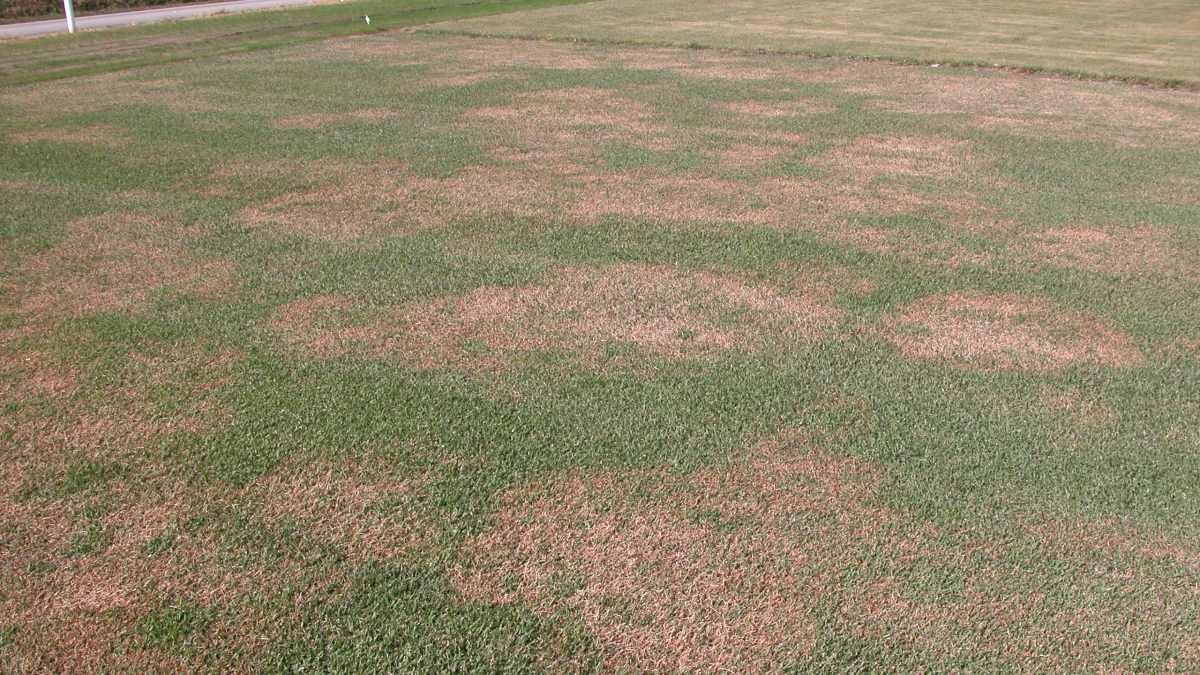
Large patch disease (LPD) is a fall and spring menace that lashes out on warm-season grasses around their dormancy time. The disease is more severe on lawns that are over-fertilized, watered too much, or mowed too short. Even so, turfgrass recovers well if you catch and treat the infection in time. Here’s how to identify, prevent, and control large patch lawn disease on your grass and keep your lawn safe, healthy, and green.
How to Recognize Large Patch Disease in Your Lawn
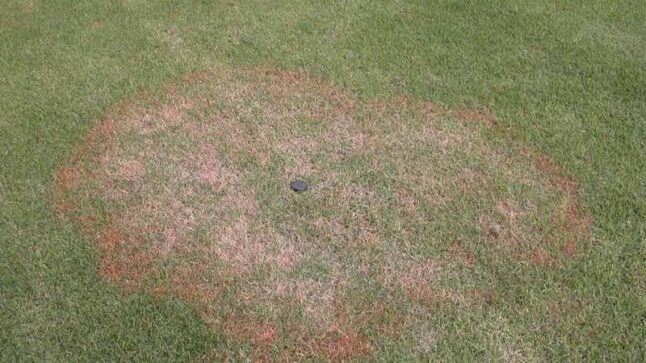
The first step in treating large patch disease is determining if LPD is what’s making the lawn sick. In this section, we tell all about:
- Signs and Symptoms of Large Patch Disease
- When is Grass Vulnerable to Large Patch Disease?
- How to Test for Large Patch Disease
- Large Patch vs. Brown Patch vs. Yellow Patch
- Other Warm-Season Grass Diseases You Can Confuse With Large Patch
- Similar Symptoms to Herbicide Damage
Signs and Symptoms of Large Patch Disease
There are many possible reasons for brown spots appearing on your lawn. It can be as simple as drought stress or soil compaction or as complicated as nutrient deficiency, fungal diseases, pests, or an unbalanced soil pH.
Between suspecting LPD and jumping in with the fungicides, take a moment to ensure it is a large patch problem. Start by checking for the main large patch disease symptoms:
- Light green patches in the fall: This is a rare one to notice since, in the fall, any affected areas are a subtle light green, easy to miss.
- Well-defined patches in the spring: Yellowish to brown circular patches appear across your turf. They can be a few inches to over 3 feet wide.
- Dark border: Patches where the fungus is still active have a darker edge.
- Frog-eye shape: Grass infected by LPD fungus rarely dies and recovers fast. Most diseased patches have green, newly grown grass bunches in the middle, giving them a frog eye or donut appearance.
- Leaf lesions: You’ll see tan, yellow, orange, and red lesions on leaf sheaths. The fungus infects the leaves closest to the soil. Leaves start to die from the tip.
- Easy-to-pull grass: A soft, dark rot occurs at the base of infected leaves. Grass blades are easily pulled from the stems.
- Root and crown: No lesions at the basal level of stems or the root level.
- Fungal signs: No visible mycelium (a fluffy, cloud-like substance that appears on top of the grass in cases of some fungal disease, but not this one). No smokey rings at the edge of the patches.
When is Grass Vulnerable to Large Patch Disease?
Large patch disease is caused by the fungus Rhizoctonia solani during fall and early spring. This busy turf villain thrives, multiplies, and kills grass blades it feeds on while soil temperatures are between 50 and 70°F.
Generally, its active period is from late August to early May, but it varies depending on your location. To find out a more precise risk window for your lawn, contact your local Cooperative Extension Office.
Heat and drought make the disease stop. Large patch disease ceases in late spring and early summer once temperatures exceed 85°F. During the warm season, damaged areas have a chance to recover.
But don’t let yourself be fooled by the neat look your grass manages to pull off by July or August. LPD is not gone. It just hides away. A tough saprophyte, this fungus survives year-round as mycelium and sclerotia in:
- Soil
- Thatch layer
- Dead leaves that are left on the lawn
- Other organic debris
If left untreated, the pathogen returns, harming more and more of your lawn each year.
How to Test for Large Patch Disease
Here’s how you can do a simple home test for large patch disease:
- Go up to the edge of an infected area of the lawn.
- Pinch the tip of a damaged grass leaf and gently pull up.
- If the leaf comes off easily in your hand, and its base is dark and smells of rot, it’s large patch disease.
Repeat the test with multiple leaves in and outside of infested areas. If grass leaves and stolons pull out together, it might be a different lawn disease called take-all root rot.
For more precise results, collect samples of symptomatic grass and send them to your local Cooperative Extension Office or plant diagnostics lab.
Large Patch vs. Brown Patch vs. Yellow Patch
You might say large patch, brown patch, and yellow patch are all part of the same fungal disease family. The same fungi, Rhizoctonia solani, causes brown and large patch diseases, while Rhizoctonia cerealis causes yellow patch disease. Here’s how to tell them apart and know which disease you have in your lawn:
| Large Patch | Brown Patch | Yellow Patch |
| Affects warm-season turf types: Centipedegrass Seashore paspalum Zoysiagrass St. Augustinegrass Bermudagrass | Affects cool-season turf types: Creeping bentgrass Tall fescue Fine fescues Perennial ryegrass Annual bluegrass Kentucky bluegrass | Affects cool and warm-season turf types: Annual bluegrass Kentucky bluegrass Bermudagrass Perennial ryegrass Zoysiagrass Bentgrasses |
| Active in Fall and Spring (50 to 80°F with high humidity) | Active in Summer (75 to 90°F with high humidity) | Active in Fall and Spring (50 to 65°F with high humidity) |
| Patch size: 1 foot to over 3 feet wide | Patch size: 4 to 12 inches | Patch size: 6 to 12 inches |
| Patch color: tan, orange, and off-color patches with an orange border and sunken center | Patch color: olive-green to brown with a gray-white smoke ring around patches with active infection | Patch color: yellow or tan-colored patches or rings; margins can be yellow or reddish-brown |
Other Warm-Season Grass Diseases You Can Confuse With Large Patch
We talked about the Rhizoctonia family villains, but there are also other nasty fungal diseases with similar symptoms that you might confuse with large patch. It’s important to know which disease is infecting your lawn so you can use the right treatment to get rid of it. The following common lawn diseases can look like large patch:
Spring Dead Spot
A cool weather disease active on warm-season grasses, spring dead spot causes circular patches of bleached-out dead grass, 6 to 12 inches wide. It mainly affects Bermudagrass, seashore paspalum, and Zoysiagrass lawns.
Dig out some damaged grass to check if it’s spring dead spot or large patch. If it’s spring dead spot, grassroots, rhizomes, and stolons are rotten and dark in color, and leaves lack defined lesions. Large patch disease doesn’t damage the roots but causes tan to orange lesions on the blades.
Leaf Rust Disease
Making golden yellow and orange-rust patches across your lawn, leaf rust disease is active in late summer and fall while temperatures stay above 60°F. Among the warm-season grasses, it appears mainly in Zoysia lawns.
You’ll distinguish it easily from large patch disease because of the orange powder that collects on your shoes when walking through the grass. The disease also causes spots on grass blades, typically aligned with the leaf veins.
Necrotic Ring Spot
This fungal disease attacks mainly cool-season grasses but can also appear in summer turf types like Bermuda. It’s active in spring and fall and starts by creating light green patches. Infected areas then develop into rings of bronze to straw-colored grass with healthy plants in the middle and a frog-eye appearance.
Necrotic ring spot affects roots, crown, and lower stems, which appear brown or black in color. To check for its presence, dig out some grass from the affected areas and see if there’s any damage at the root level.
Take-All Root Rot
Another fungal disease that preys on warm-season grasses as they exit dormancy, take-all root rot (TARR) begins its damage with chlorotic, light green to yellow patches. Discolored spots can be a few inches to a few feet wide. The grass eventually turns brown, thins out, and affected patches become bare areas.
Bare patches are a tell-tale of TARR. You won’t see them with large patch disease, which is more forgiving in lawns. Also, TARR acts in warmer weather, from late spring to summer, damaging stolons and rhizomes, giving them dark lesions and rot. The leaves have no distinctive lesions, as they do with large patch.
Similar Symptoms to Herbicide Damage
It’s common to confuse LPD with herbicide damage and vice versa in St. Augustinegrass. Herbicides can cause the same type of yellow to brown patches, and leaves may pull off easily from stems.
The difference is that, when grass is suffering from herbicide damage, the base of the leaf doesn’t have a dark color or a smell of rot like with LPD. Instead, with herbicide damage, the leaf base is dry and discolored, with a tan color.
How to Treat Large Patch Disease
To get LPD out of your lawn, you need proper lawn maintenance practices and the help of effective fungicides. Cultural practices and fungicides are both important to the process, and either one without the other will be less successful at getting rid of the fungus for good:
Cultural Practices During Large Patch Infestation
The moment you suspect a fungal disease in your lawn is the perfect time to get some specific cultural practices going. They are meant to reduce conditions favorable for fungal development and limit fungi spread to healthy areas. Here are the do’s and don’t’s for homeowners with large patch disease in their lawns.
Do:
- Mow less often if possible. Your lawn mower can spread the fungus from diseased patches to healthy grass.
- Always mow diseased areas last. This way, you avoid getting fungi in healthy zones of your lawn.
- Collect all grass clippings from an infested lawn and dispose of them. Don’t use the clippings as mulch or in your compost bin.
- Clean and disinfect the lawn mower and all lawn care equipment after working in diseased areas. Also, clean your shoes and pants before working in your flower beds or vegetable garden. The large patch fungus doesn’t spread spores, but the mycelium is easily transported and spread on tools, clothes, animals, etc.
Don’t:
- Avoid dethatching and aerating the lawn when infested. You might spread the fungi even more.
- Never water in the evening if you already have a fungal disease in your lawn. Make watering an early morning routine.
- Stop irrigating on the standard schedule. Check the soil and grass before irrigating to avoid adding excess moisture.
- Stop watering if it rains. Again, the goal is to avoid excess moisture, which fosters fungal development.
Chemical Treatments
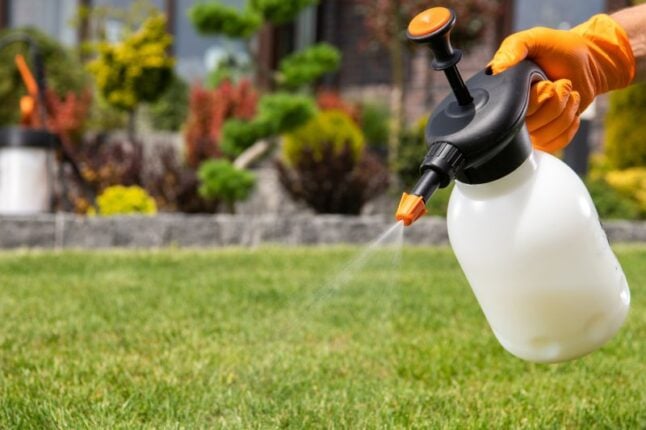
Large patch disease is not particularly nasty as a one-time infestation. Most of the turf recovers during the summer with proper care. The disease’s dark side is the hardy fungal structures that survive winter cold and summer heat and return more virulent each year. The sooner you stop this fungus dead, the better. That’s where fungicides come in.
Preventive Applications
Fungicides work better against LPD in preventive applications. Make the first in the fall, when environmental conditions start favoring the LPD fungus. According to North Carolina University, this happens when:
- Temperatures go below 80 degrees for 5 consecutive days for St. Augustine and centipedegrass lawns.
- Temperatures go below 70 degrees for 5 consecutive days for Zoysiagrass lawns.
Make a second application after 4 to 6 weeks. Repeat the fungicide treatment more times if you’re dealing with a severe infestation.
Effective Fungicides
Among the best lawn fungicides to use for chemical control of large patch are azoxystrobin, chlorothalonil, fluoxastrobin, flutolanil, metconazole, propiconazole, myclobutanil, thiophanate-methyl, triadimefon, and tebuconazole.
These active ingredients are included in various commercial fungicides available from garden centers and online shops. Some of the most popular fungicides used to treat LPD are:
Fungicide application rates differ depending on the type of grass, so make sure to follow the label directions carefully.
The big problem with fungicides is that they can be expensive and difficult to get ahold of for non-professionals. You might actually save money by hiring a lawn treatment pro to apply fungicides for you.
Lawn Repair Options After Large Patch Disease
Symptoms of large patch disease stay a while in your lawn. They only disappear when new grass blades grow, and you remove the damaged ones gradually by mowing and collecting the grass clippings.
LPD attacks in the fall, and you’ll see the symptoms in the spring. These times are when warm-season grasses are slow to grow, so it will take a while to return to a green lawn. Here’s what you can do to shorten the waiting time.
Paint the Lawn
Yes, lawn paint is a real thing. It’s a safe product made of non-toxic, biodegradable substances that don’t hurt the grass. Turf paint is also safe for pets and kids, affordable, and easy to use. You apply it on off-color areas, and the lawn looks green again in a few minutes.
We’ve got a detailed guide on grass paint and how to use it that can help you figure out this post-disease turf repair option. Grass paint is available in garden stores and online retail shops.
Here are a few popular products used for home lawns:
- Endurant Green Grass Paint (Amazon)
- Ever Green Grass Colorant Concentrate (Home Depot)
- Lawnlift Ready to use Grass paint (Walmart)
Plant Bermudagrass
Bermudagrass is the least vulnerable warm-season grass to LPD. It gets the fungi, but the damage is minimal, and recovery is quick. Consider changing from Zoysia, St. Augustine, or Centipede to Bermuda if LPD frequently appears on your lawn. You can do this by overseeding your lawn with Bermudagrass seed or ripping up the old grass and starting from scratch.
Fertilize Wisely To Help Grass Recover
Once the fungus has been fought back, the weather starts to get warmer, and the grass grows a little faster, consider helping it with the right kind of fertilizer. Apply small amounts of balanced fertilizer with slow-release nitrogen and potassium.
How To Prevent Large Patch Disease
Preventive measures are the best way to keep large patch disease at bay and limit damage in case of infestation. Here’s what you can do to protect your beautiful green lawn from LPD:
Avoid Overwatering
Irrigate deeply and less often. Get the water to penetrate the soil about 4 to 6 inches deep every time. Schedule the next watering session when your grass shows signs of stress like wilting, a grayish tint on its green blades, and a delay in recovering after walking on the lawn.
Install a good-quality sprinkler system. You need it to apply water uniformly. Leave the timer off in the spring and fall, and start only when the turf needs watering.
Water in the early morning to limit water loss through evaporation and keep the watering frequency low. Soon after dawn is the best time to irrigate because it allows the soft morning sunlight time to dry the water sprinkled on the leaves and the thatch surface.
Ensure Effective Air Circulation
Trim any trees and shrubs shading or edging the lawn. Less dense foliage allows air to flow better and dry out excessive moisture.
Mow the grass at a proper height. Scalped lawns tend to grow too dense in mild and rainy weather. They capture moisture and prevent air from circulating properly. Here are the recommended mowing heights for the most common warm-season turfgrasses to guide you.
| Grass Type | Recommended Mowing Height | Mow When The Grass Reaches This Height |
| Bermudagrass (seeded) | 1 – 1.5 | 1.5 – 2.25 |
| Hybrid Bermuda | 0.5 – 1 | 0.75 – 1.5 |
| Centipedegrass | 2 | 3 |
| St. Augustinegrass | 2.5-3 | 3.75-4.5 |
| Zoysiagrass | 0.5 – 1 | 0.75 – 1.5 |
We also have a detailed guide on lawn mowing with all the professional tips and tricks you need to know to cut the lawn the right way.
Remove grass clippings during the wet season. Even with no infestation, removing grass clippings from the lawn during rainy periods is better since it improves airflow and water evaporation.
Improve Soil Drainage
Improving soil drainage is critical if fall and spring are rainy seasons in your area. Take care of these essential lawn maintenance tasks annually to ensure proper soil permeability:
Keep the lawn free of thatch. Once the thatch layer gets over 0.5 inches thick, remove it by dethatching the lawn to promote water absorption and airflow and avoid propagation of LPD fungi if the thatch houses dormant mycelium. You can rent or buy a dethatching rake/verticutter or hire a lawn care service to dethatch your lawn for $0.15 to $0.35 per square foot.
Aerate the soil. The compacted ground absorbs water slowly, promoting puddles, runoff, and prolonged humidity. Use a core aerator to loosen the soil and ensure it can drain water properly.
The best time to schedule soil maintenance like aeration and dethatching is during the growing season when mechanical damage can easily be overcome.
Reduce foot traffic on the lawn during fall and spring. It prevents further compaction and grass damage when the turf is semi-dormant and most vulnerable.
Install a drainage system like a French drain or a collecting pond to solve severe drainage problems across the yard.
Clean the gutters and ensure rainwater drains properly and doesn’t flood the lawn. Placing rain barrels to collect rainwater is another good way to reduce puddling in your lawn.
Fertilize Correctly
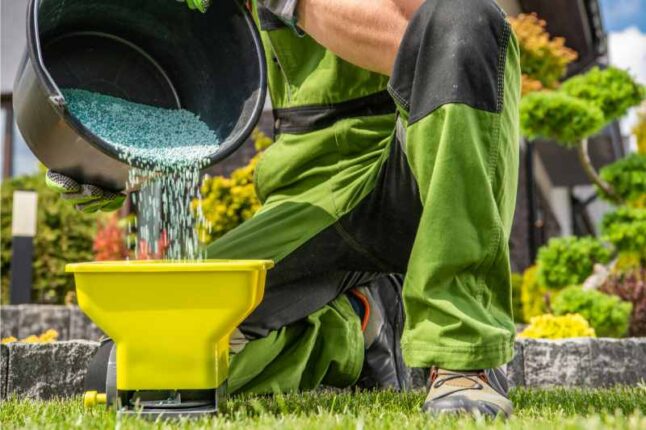
Too much nitrogen at the wrong time makes grass grow tall and lush, with tender leaves, and easier to penetrate by large patch disease fungi. Use fertilizer properly to give your turf more strength and energy to fight the infection instead of supporting it.
- Avoid adding too much nitrogen in late summer and fall (the last six weeks before dormancy), when warm-season grasses prepare for winter rest.
- When spring comes, wait at least three weeks from the first days of greening up until fertilizing. During this time, grass plants grow too slowly to require extra nutrients.
- Use slow-release fertilizer and a balanced formula with potassium to help roots grow more robust and make the grass more resilient to diseases.
To help you get started on the right foot, check out our guides on applying fertilizer correctly, choosing the right fertilizer, and the best time to fertilize.
Turfgrass Types Susceptible to Large Patch Disease
Considered one of the most common lawn diseases, large patch prefers warm-season grasses. If you’re growing a cool-season lawn and noticing similar symptoms, you’re probably dealing with another fungus.
All warm-season turfgrasses are affected by LPD, but some recover more quickly than others.
- Centipedegrass and seashore paspalum are the most vulnerable and recover the hardest.
- Kuyuku and Zoysiagrass are also at the top of the list of affected grasses (you’ll sometimes see large patch disease referred to as Zoysia patch).
- St. Augustine is next in line. It recovers a bit faster.
- Bermuda is the most resilient.
Factors that Favor Large Patch Disease
Large patch disease is encouraged and supported by soil surface moisture more than other factors. Infection is possible at the lower leaf sheath level if the thatch temperature is between 50 to 70°F. But, it only happens when the moisture level is high for at least 48 hours.
Here are the top factors leading to the moisture conditions LPD needs to take over your lawn.
Soil Compaction And Standing Water
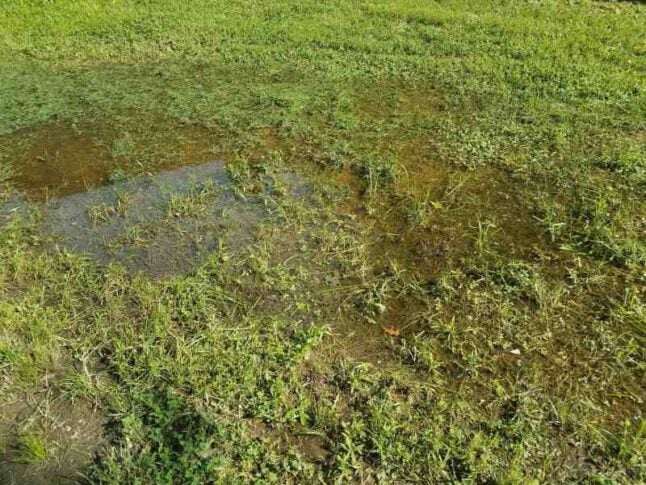
Compacted soil favors puddles and prolonged moisture in the turfgrass canopy, the ideal environment for any fungi to thrive, including Rhizoctonia solani. It also limits root development. Diseased grass with a compromised root system takes longer to recover.
Thick Thatch
A layer of thatch over ½-inch thick keeps moisture around the grass stems and leaves. It prevents water from evaporating and also stays wet for a long time.
As a “bonus” feature, thatch is one of the favorite shelters fungi use to protect themselves during winter and summer when they go dormant. Overall, thick thatch is a ticking fungal bomb ready to blow anytime. Therefore, you should look for signs your lawn has excessive thatch so you can resolve the issue quickly.
Turfgrass in Low-Lying Areas
Having the same lush, green carpet across your entire yard is lovely. But if you have low spots, you must level that yard area before planting grass. Such zones can become perfect nurseries for fungi since they collect runoff moisture from watering and rainfall.
Low Mowing Heights Keep Air Trapped
Close-mowed grass develops a denser canopy, limiting airflow and encouraging fungal development.
In Zoysiagrass, lowering lawn mower blades from 1.5 to 0.5 inches drastically increases LPD severity. Ensure you always keep the turf at the proper mowing height for your grass type and the time of year.
Excessive Watering Increases Soil Moisture
Prolonged soil moisture is the primary condition favoring fungal infections. It’s usually caused by watering the lawn often and in small amounts, faulty irrigation systems, or ignoring rainfall and air humidity.
Restricted Air Movement and Shade
A dense tree or shrub canopy provides shade and limits air circulation. While enjoying shade above your relaxing outdoor spots is pleasant, covering your lawn exposes the grass to LPD infestations with severe damage.
FAQ About Large Patch Disease
Why does my lawn have large brown patches?
Brown patches on your lawn can have several different causes, starting with drought stress, soil compaction, nutrient deficiency, and overfertilization, and ending with pests and fungi. Before starting a treatment, always ensure you know exactly the cause.
How do you treat large patch disease?
Large patch disease is caused by fungi and is supported by soil moisture. To prevent it and treat it, you avoid overwatering, remove the thatch, aerate the soil, keep the soil moisture level low, and make applications with proper fungicides made with active ingredients like azoxystrobin, chlorothalonil, metconazole, propiconazole, thiophanate-methyl, or triadimefon.
Will nitrogen fertilizer help large patch?
Large patch disease is more severe in overfertilized lawns. Don’t apply nitrogen to treat the disease. It can support disease development instead of stopping it.
Does summer heat kill the large patch disease fungus?
Not exactly. Heat is an unfavorable development condition for the LPD fungi, so they hide in the soil and thatch as mycelium or sclerotia. The fungi stay dormant until the weather becomes friendly and infects the lawn again. You’ll typically need to use a fungicide to eliminate the infection completely.
Does large patch disease kill the grass?
Typically, LPD doesn’t kill the grass because it only harms the leaves and leaf sheaths, and healthy plants sprout again from their roots. But it will thin your lawn, and, if the infection repeats yearly, the damage will cover more and more area each year.
Get Help with Large Patch and Other Lawn Diseases
There’s little space for improvisation when you deal with fungal diseases on your lawn. Always ensure you know exactly what disease you have and how to treat it to avoid severe damage. Keep in mind that LawnStarter can put you in contact with the best lawn treatment pros in your area in just a few minutes. Pros have the experience to diagnose whatever’s harming your lawn, and they have the tools to treat the problem.
Main Photo Credit: NC State Cooperative Extension